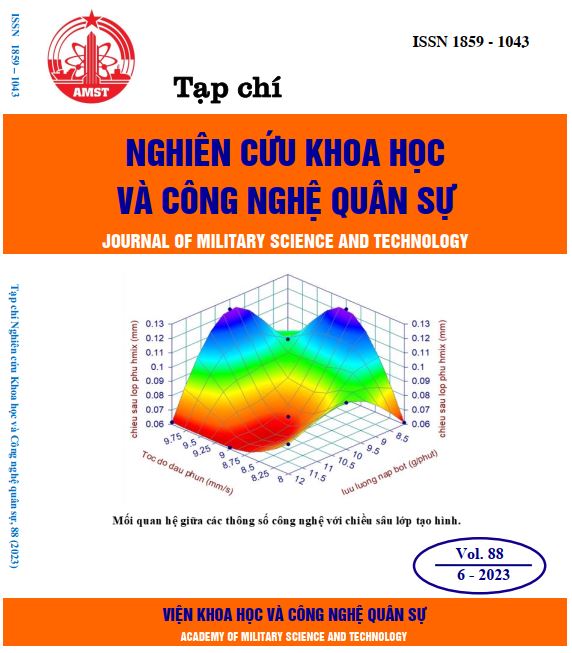Heparin - Pluronic F127 nanogel with optimal component ratio for drug delivery applications
490 viewsDOI:
https://doi.org/10.54939/1859-1043.j.mst.88.2023.58-65Keywords:
Heparin; Nanogel; Platin drug; Pluronic F127; Poor water-soluble drug.Abstract
This study aimed to synthesize a nanogel system based copolymers of Heparin (Hep) and Pluronic F127 (F127) with optimal Hep:F127 ratio for delivering poor water soluble drug and Platinum-based drugss. Firstly, Hep-F127 conjugates were formed via disulfide bridges of cystamine molecules. The obtained Hep-F127 systems were then proved and characterized using Proton nuclear magnetic resonance (1H-NMR), Dynamic Light Scattering (DLS)) methods. Cisplatin (CPT) was used as the Pt drug model, meanwhile Paclitaxel (PTX) was used as poor water-soluble drug model. The encapsulation ability for CPT and PTX was investigated and compared to choose the optimal Hep-F127 ratio. This Hep-F127 nanogel system is expected to be a good carrier for delivering drugs with different properties.
References
[1]. Cerqueira, M.A., et al., "Structural and thermal characterization of galactomannans from non-conventional sources". Carbohydrate polymers, 83(1): p. 179-185, (2011). DOI: https://doi.org/10.1016/j.carbpol.2010.07.036
[2]. Yao, Y., et al., "Nanoparticle-based drug delivery in cancer therapy and its role in overcoming drug resistance". Frontiers in molecular biosciences, 7: p. 193. (2020). DOI: https://doi.org/10.3389/fmolb.2020.00193
[3]. Hassanzadeh, P., F. Atyabi, and R. Dinarvand, "The significance of artificial intelligence in drug delivery system design". Advanced drug delivery reviews, 151: p. 169-190. (2019). DOI: https://doi.org/10.1016/j.addr.2019.05.001
[4]. Jarak, I., et al., "Pluronic-based nanovehicles: Recent advances in anticancer therapeutic applications". European Journal of Medicinal Chemistry, 206: p. 112526. (2020). DOI: https://doi.org/10.1016/j.ejmech.2020.112526
[5]. Pitto-Barry, A. and N.P. Barry, "Pluronic® block-copolymers in medicine: from chemical and biological versatility to rationalisation and clinical advances". Polymer Chemistry, 5(10): p. 3291-3297. (2014). DOI: https://doi.org/10.1039/C4PY00039K
[6]. Nguyen, T.T.C., et al., "Highly lipophilic pluronics-conjugated polyamidoamine dendrimer nanocarriers as potential delivery system for hydrophobic drugs". Materials Science and Engineering: C, 70: p. 992-999. (2017). DOI: https://doi.org/10.1016/j.msec.2016.03.073
[7]. Xu, C., B. Wang, and S. Sun, "Dumbbell-like Au− Fe3O4 nanoparticles for target-specific platin delivery". Journal of the American Chemical Society, 131(12): p. 4216-4217. (2009). DOI: https://doi.org/10.1021/ja900790v
[8]. Park, S.S., et al., "Functionalised mesoporous silica nanoparticles with excellent cytotoxicity against various cancer cells for pH-responsive and controlled drug delivery". Materials & design, 184: p. 108187. (2019). DOI: https://doi.org/10.1016/j.matdes.2019.108187
[9]. Kemp, M.M. and R.J. Linhardt, "Heparin‐based nanoparticles". Wiley Interdisciplinary Reviews: Nanomedicine and Nanobiotechnology, 2(1): p. 77-87. (2010). DOI: https://doi.org/10.1002/wnan.68
[10]. Argyo, C., et al., "Heparin‐Coated Colloidal Mesoporous Silica Nanoparticles Efficiently Bind to Antithrombin as an Anticoagulant Drug‐Delivery System. Chemistry"–A European Journal, 18(2): p. 428-432. (2012). DOI: https://doi.org/10.1002/chem.201102926
[11]. Peng, X.-H., et al., "Targeted delivery of cisplatin to lung cancer using ScFvEGFR-heparin-cisplatin nanoparticles". Acs Nano, 5(12): p. 9480-9493. (2011). DOI: https://doi.org/10.1021/nn202410f
[12]. Nguyen, N.T., et al., "Synergic activity against MCF-7 breast cancer cell growth of nanocurcumin-encapsulated and cisplatin-complexed nanogels". Molecules, 23(12): p. 3347. (2018). DOI: https://doi.org/10.3390/molecules23123347
[13]. Truong-Thi, N.-H., et al., "pH-Responsive Delivery of Platinum-based Drugs through the Surface Modification of Heparin on Mesoporous Silica Nanoparticles". European Polymer Journal, p. 111818. (2023). DOI: https://doi.org/10.1016/j.eurpolymj.2023.111818
[14]. Golla, E.D. and G.H. Ayres, "Spectrophotometric determination of platinum with o-phenylenediamine". Talanta, 20(2): p. 199-210. (1973). DOI: https://doi.org/10.1016/0039-9140(73)80267-X
[15]. Trang Le, N.T., et al., "Preparation of liposomal nanocarrier by extruder to enhance tumor accumulation of paclitaxel". Journal of Bioactive and Compatible Polymers, 37(1): p. 3-16. (2022). DOI: https://doi.org/10.1177/08839115211053926
[16]. Vu, M.T., et al., "Development and characterization of soy lecithin liposome as potential drug carrier systems for codelivery of letrozole and paclitaxel". Journal of Nanomaterials, p. 1-9. (2020). DOI: https://doi.org/10.1155/2020/8896455
[17]. Vu, M.T., et al., "Development, characterization and in vitro evaluation of paclitaxel and anastrozole Co-loaded liposome". Processes, 8(9): p. 1110. (2020). DOI: https://doi.org/10.3390/pr8091110
[18]. Le, N.T.T., et al., "Methoxy polyethylene glycol–cholesterol modified soy lecithin liposomes for poorly water‐soluble anticancer drug delivery". Journal of Applied Polymer Science, 138(7): p. 49858. (2021). DOI: https://doi.org/10.1002/app.49858
[19]. Shaikhullina, M., et al., "NMR relaxation and self-diffusion in aqueous micellar gels of pluronic F-127". Journal of Molecular Liquids, 306: p. 112898. (2020). DOI: https://doi.org/10.1016/j.molliq.2020.112898
[20]. Choi, J.H., et al., "Self-assembled nanogel of pluronic-conjugated heparin as a versatile drug nanocarrier". Macromolecular research, 19(2): p. 180-188. (2011). DOI: https://doi.org/10.1007/s13233-011-0214-4
[21]. Pomin, V.H., "1H and 15N NMR analyses on heparin, heparan sulfates and related monosaccharides concerning the chemical exchange regime of the N-sulfo-glucosamine sulfamate proton". Pharmaceuticals, 9(3): p. 58. (2016). DOI: https://doi.org/10.3390/ph9030058
[22]. Nguyen, D.H., et al., "Targeting ligand-functionalized and redox-sensitive heparin-Pluronic nanogels for intracellular protein delivery". Biomedical Materials, 6(5): p. 055004. (2011). DOI: https://doi.org/10.1088/1748-6041/6/5/055004
[23]. Mitchell, M.J., et al., "Engineering precision nanoparticles for drug delivery". Nature Reviews Drug Discovery, 20(2): p. 101-124. (2021). DOI: https://doi.org/10.1038/s41573-020-0090-8
[24]. Chen, F., et al., "Engineering of hollow mesoporous silica nanoparticles for remarkably enhanced tumor active targeting efficacy". Scientific reports, 4(1): p. 1-10. (2014). DOI: https://doi.org/10.1038/srep05080







